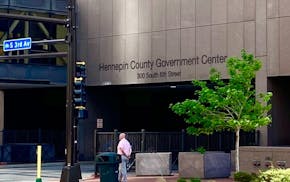Most people aren't thinking about clearing snow from sidewalks in May.
But it's a hot topic at Bloomington City Hall this summer, as city officials consider reducing the miles of sidewalks city workers clear after snowstorms. Instead, they would shovel some of that responsibility on to homeowners and businesses.
"It's really to improve walkability for everybody," said Dave Hanson, assistant director for Parks and Natural Resources.
The discussion is happening now in the hopes of receiving resident feedback and reaching a solution before the snow flies again, and it highlights a conflict other cities are facing — or will — as suburban sidewalk networks continue to expand across the Twin Cities metro area.
More often than not, metro area residents and businesses are responsible for clearing the sidewalks along their properties. But some cities, including Richfield and Burnsville, take care of some of the sidewalk snow-removal duties. Others have considered adopting a city-plowing approach because of residents' varied dedication to shoveling.
Minneapolis studied what it would cost for the city to clear snow from its nearly 2,000 miles of sidewalk. The estimated bill? More than $116 million in the first three years. The city started a pilot to help some residents clear snow.
Andrew Wrucke, of the University of Minnesota's Center for Transportation Studies, said the debate underscores a challenge cities face whenever they're expanding infrastructure: "Who maintains it?"
"Some cities don't clear their sidewalks at all. It's all on the homeowners," Wrucke said. "Some cities do their own maintenance, but that's because they have a very small amount of sidewalks."
Bloomington proposes less plowing
Bloomington has been clearing the sidewalks for many years, Hanson said, "even though we have an ordinance on the books that goes back to 1958 that puts that responsibility on the adjacent property owner."
When the city began developing in the post-World War II era, sidewalks weren't a big thing. That's changing now, and Bloomington now has more than 260 miles of sidewalk.
Plowing all of them has become a challenge, and something residents call about, Hanson said.
"We don't get out there and do them fast enough," he said. In some situations it can take up to three days to get sidewalks done.
He said sidewalks present other challenges, too: The uneven surfaces can catch the plow blades, stopping the machines abruptly and causing driver injury. Salt isn't a good option because it's bad for the environment, and sidewalks don't drain like streets. And there's also the matter of damaged sod and other property, for which the city sometimes reimburses property owners.
That's why Bloomington is considering a proposal to cut 91 miles of business and residential sidewalks from the city's plow routes so that public works employees can focus on sidewalks along city property and main roads.
Hanson said he believes turning the job over to residents would actually result in sidewalks being cleared faster.
The city is also considering changing the required timeframe for removing snow from 12 hours — something the city can't meet now — to 24 hours, more in line with other cities where residents are responsible for snow clearing.
Reducing the sidewalk plowing mileage would free up considerable staff time to maintain parks and ice rinks and do work on trees, some of which is best done in winter.
Like Bloomington, Richfield plows all of its growing city sidewalk system. The city does one pass, and then it's up to property owners to do any additional snow removal, said Chris Link, Richfield's deputy public works director.
But he said Richfield is having internal discussions like Bloomington's as the sidewalk mileage expands.
"If you want passable sidewalks during the winter, who are the best people to do it?" he said. "With the system level that we have today and the staffing levels that we have today, I still think it's us, but I do understand the concern around it because it does take a lot of time."
Burnsville also plows all of its more than 130 miles of sidewalks and trails.
Public Works Director Mark Ray said cities have to balance cost and scale with any government service. For less-dense Burnsville, he said, city sidewalk snow removal is difficult, but it makes sense.
Burnsville also has a little help from taxpayers to pay for sidewalk plowing.
"It's charged on the utility bill for us doing snow removal for properties that are directly adjacent to those sidewalks," he said.
Residents split on snow removal
Bloomington is gathering resident feedback this summer on its sidewalk plowing proposal. Hanson said he's heard from residents who support it and those who oppose it.
Resident Heather Hamilton Tourville said she'd prefer the city continue to plow sidewalks and would be willing to pay more taxes to keep it that way.
She said many people who have bought homes in Bloomington did so with the understanding that sidewalks were city-plowed. She noted that could have factored into why they chose to buy in Bloomington instead of a nearby suburb like St. Louis Park, where sidewalk clearing is typically handled by residents.
"A lot of older, elderly or disabled people who just can't do it themselves kind of expected that to be built in," she said.
She also voiced concern that sidewalks could be inconsistently shoveled if turned over to residents.
Dustin Nguyen said the status quo is often slushy, messy sidewalks.
"A three-day turnaround period between snowfall and sidewalks being cleared isn't accessible either," he wrote in an email to the Minnesota Star Tribune.
He said he thinks turning some streets over to residents will improve the timeframe for clearing sidewalks.
He said he understands concerns that Bloomington's seniors won't be able to shovel their walks, but said it could also be a chance to encourage neighbors to help each other out.
Residents can fill out an online survey and city staff will be at the Bloomington Farmers Market on June 7 gathering residents' thoughts.
The city's Public Works Department is expected to make a final route recommendation in July.
Astrologer fuels hunger for horoscopes five days a week from St. Paul

Jury convicts man who grabbed girl, 12, from Twin Cities backyard and raped her
17 miles of Minneapolis streetlights are out from copper theft. The city is scrambling to fix them.

